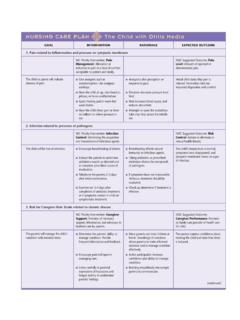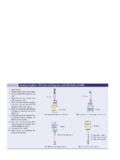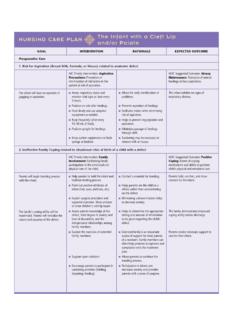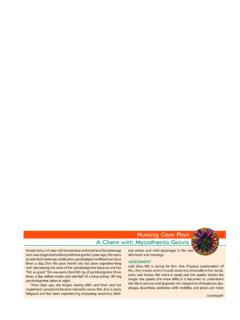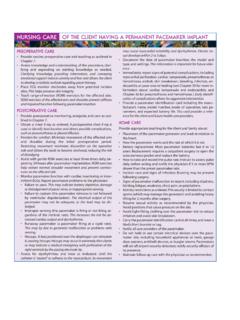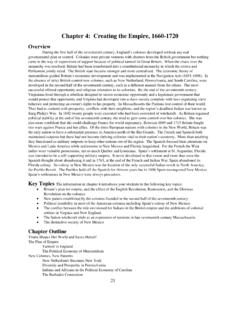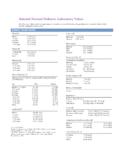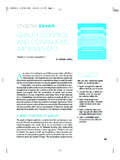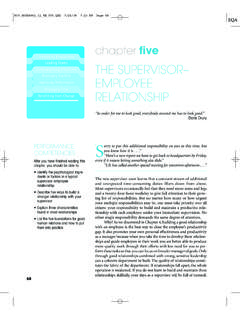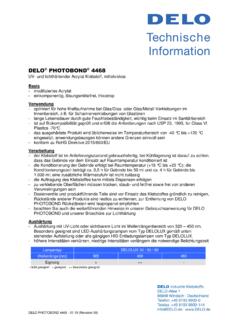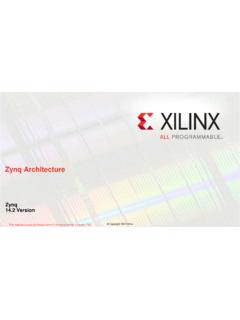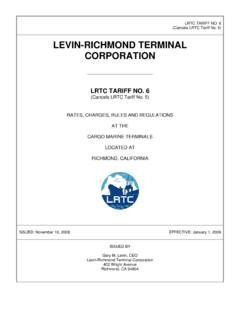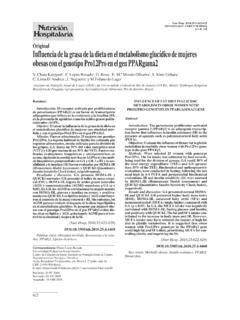Transcription of Concentrations and Dilutions - Pearson Education
1 Concentrationsand DilutionsAfter completing this chapter, youshould be able to: Calculate weight/weightpercent Concentrations . Calculate weight/volumepercent Concentrations . Calculate volume/volumepercent Concentrations . Calculate Dilutions of of many pharmaceutical preparations areexpressed as a percent strength. This is an important conceptto understand. Percent strength represents how many gramsof active ingredient are in 100 mL. In the case of solids suchas ointment, percent strength would represent the number ofgrams contained in 100 g.
2 Percent strength can be reduced toa fraction or to a decimal, which may be useful in solvingthese calculations. It is best to convert any ratio strengths to apercent. We assume that 1 g of solute displaces exactly 1 mLof liquid. Therefore, you will notice that grams and millilitersare used interchangeably depending on whether you areworking with solids in grams or liquids in earning 8/29/07 12:55 PM Page 2526 Chapter Six Concentrations and DilutionsConcentrationsWEIGHT/WEIGHTP ercent Concentrations for solids such as ointments or creams are expressedas % w/w.
3 You can determine these by establishing a proportion and thenconverting it into a percentage, as discussed in Chapter weight/weight Concentrations can be easily and accuratelyperformed by following these up a proportion with the amount of active ingredient listed over thetotal quantity, as grams over the proportion to a decimal (by dividing the numerator by thedenominator). the converted number by 100 to express the finalconcentration as a g of active ingredient powder is mixed with 99 g of whitepetrolatum.
4 What is the final concentration [w/w]?Let s look at the information that has been provided and iscritical to solving the calculation:1 g active ingredientamount of active99 g white petrolatumamount of base100 g*total quantity (1 g of active 99 g of the base)*It is important to be careful in determining the amount for thetotal quantity. If you do not add both the active and base quantitiesfor the total quantity, if not listed, the calculation will be set upincorrectly from the very start!The first step is to set up a proportion with the amount of active ingredientlisted over the total , convert the proportion to a decimal by dividing the numerator bythe , multiply the converted number by 100 to express the final concen-tration as a , the final weight/weight concentration is 1%.
5 *100=1%1 g,100 g= g (active)100 g (total) 8/29/07 12:55 PM Page 26 Chapter Six Concentrations and Dilutions27 EXAMPLE g of active ingredient powder is in a 120 g compounded is the concentration [w/w]?Let s look at the information that has been provided and iscritical to solving the calculation:12 g active ingredientamount of activenot providedamount of base120 g*total quantity*In this example, we are not provided with the amount of base,but only the amount of active ingredient and the total set up a proportion with the amount of active ingredient listed overthe total , convert the proportion to a decimal by dividing the numerator bythe , multiply the converted number by 100 to express the final con-centration as a , the final weight/weight concentration of the compoundedcream is 10%.
6 EXAMPLE g of a compounded ointment contains 105 mg of neomycinsulfate. What is the final concentration [w/w]?Let s look at the information that has been provided and iscritical to solving the g* active ingredientamount of activenot providedamount of base30 gtotal quantity*To accurately perform concentration calculations, the proportionmust be set up as grams over grams. In this example, the problemprovides the amount of active ingredient in milligrams, which mustbe converted to up a proportion with the amount of active ingredient listed over thetotal , convert the proportion to a decimal by dividing the numerator bythe g,30 g= g (active)30 g (total) *100=10%12 g,120 g= g (active)120 g (total) 8/29/07 12.
7 55 PM Page 2728 Chapter Six Concentrations and DilutionsNow, multiply the converted number by 100 to express the final concen-tration as a final weight/weight concentration is you add 3 g of salicylic acid to 97 g of an ointment base, what isthe final concentration [w/w] of the product?Let s look at the information that has been provided and iscritical to solving the calculation:3 g active ingredientamount of active97 gamount of base100 gtotal quantity (3 g 97 g)Set up a proportion with the amount of active ingredient listed over thetotal , convert the proportion to a decimal by dividing the numerator bythe the converted number by 100 to express the final concentrationas a final weight/weight concentration of the ointment is 3%.
8 EXAMPLE much oxiconazole nitrate powder is required to prepare thisorder?Rx 1% Oxiconazole Nitrate OintmentDisp. 45 gLet s look at the information that has been provided .. andwhat is providedamount of activenot providedamount of base45 gtotal quantity1% *100=3%3 g,100 g= g (active)100 g (total) *100= 8/29/07 12:55 PM Page 28 Chapter Six Concentrations and Dilutions29 Now this problem has given us the final concentration, and we arebeing asked to determine the amount of active ingredient needed. Noticethat, in essence, the previous examples could be solved by using theformula until this point, we have been able to solve for the final % strength byfilling in the other amounts and solving.
9 This is the same approach thatwe will take to solving this problem; the only difference is that we will besolving for the number of grams of active the information we know and the formula above, let s fill in every-thing we solve for x, the unknown quantity of active ingredient, we can divideboth sides of the equation by 100 .. which will cancel it out on the left sideand create a fraction on the right , we have a ratio and proportion, which can be solved by cross mul-tiplication and solving for ..Now, we can divide both sides by 100 to solve for x(the quantity of ac-tive ingredient needed).
10 So, g or 450 mg of oxiconazole nitrate powder is needed for thisorder. x= 100x100=45100100x=451*45=45x*100=100xx g (active)45 g (total)=1100x g (active)45 g (total)*100100=1100x g (active)45 g (total)*100=1%g Activeg Total Qty*100=Final % 8/29/07 12:55 PM Page 2930 Chapter Six Concentrations and DilutionsEXAMPLE much fluorouracil powder is in 5% Efudex cream 25 g?Let s look at the information that has been providedamount of activenot providedamount of base25 gtotal quantity5%finalAgain, this problem has given us the final concentration, and we arebeing asked to determine the amount of active ingredient the information known and the formula, fill in everything you both sides of the equation by 100 to set up a ratio and proportionwhich can be , we have a ratio and proportion, which can be solved by cross mul-tiplication and solving for.

